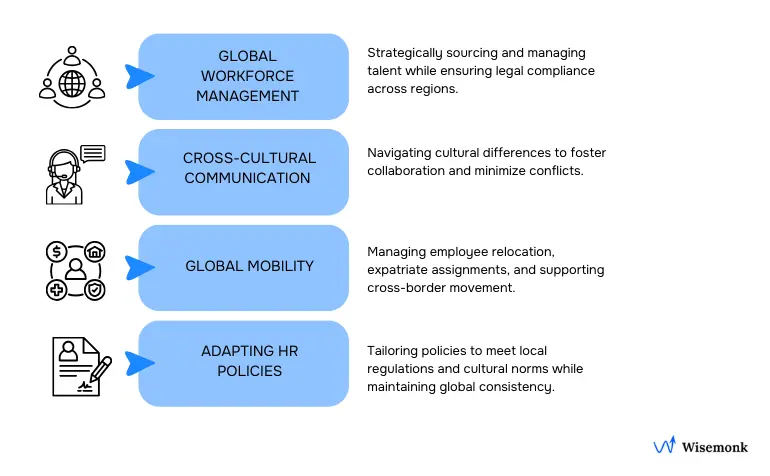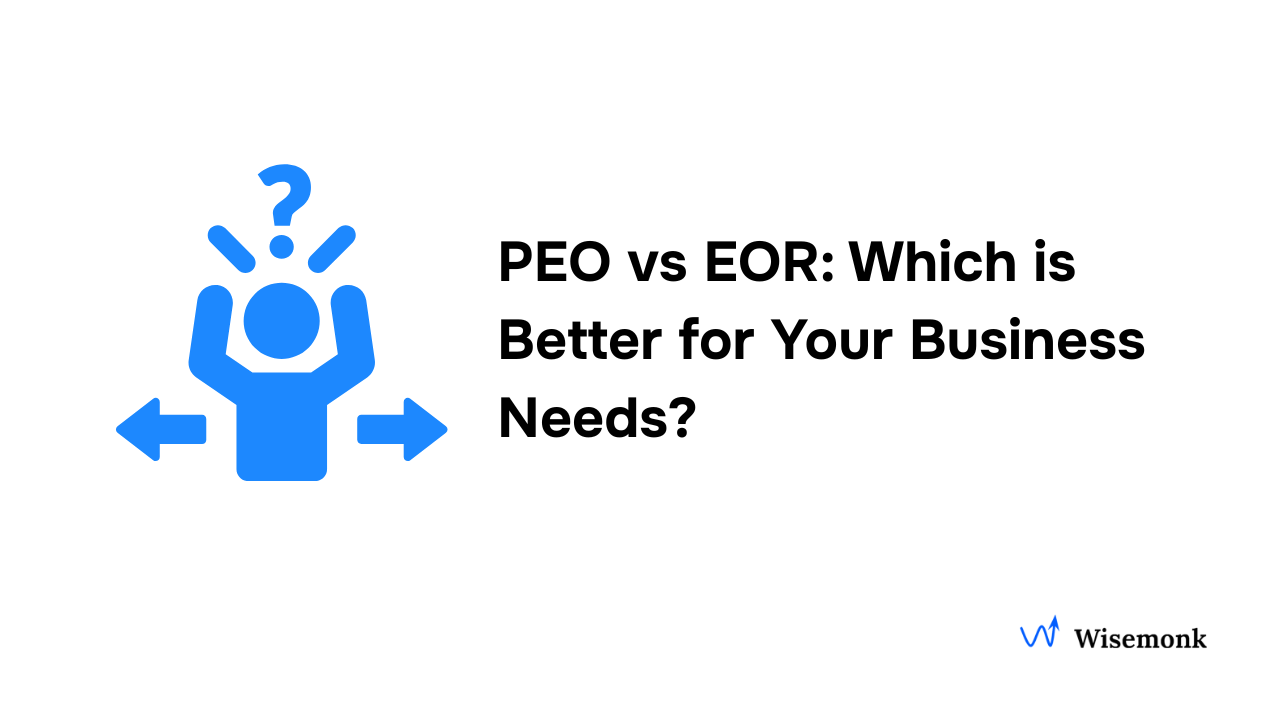- International Human Resource Management (IHRM) involves strategically managing human capital across borders, adapting HR functions to local legal, cultural, economic conditions, aligning HR strategies with business goals.
- The main functions of International Human Resource Management (IHRM) involve managing HR activities on a global scale, including global talent acquisition, compensation, training, and expatriate management.
- The key theme of strategic HR solutions for global companies involves addressing complex challenges such as cultural integration, compliance with local and international laws, and effective global talent management.
- The key challenges of operating internationally in HR include managing cultural differences, staying compliant with evolving labor laws, and navigating political and economic risks in various regions.
Need guidance on International Human Resource Management? Talk to our experts today!
Discover how Wisemonk creates impactful and reliable content.
Are you struggling to manage a diverse, global team across multiple countries? Many U.S. businesses, founders, and global teams face the challenge of navigating international human resource management, balancing cultural differences, local compliance, and a growing need for global talent. It’s no easy task, but don’t worry, we’re here to help.
As shared by a Reddit contributor, understanding local laws is crucial in HR, particularly in countries like the Netherlands. They highlight that even minor mistakes in contract wording or visa applications can lead to significant consequences for both the company and the employee. This highlights just one of the many complexities businesses face when managing a global workforce.
In this blog, we’ll break down the key strategies, challenges, and best practices for international human resource management, so you can streamline your global HR processes and build a strong, compliant, and cohesive team. Let’s dive in.
What is International Human Resource Management (IHRM)?[toc=What is IHRM]
International Human Resource Management (IHRM) is the strategic management of human capital across national borders, requiring HR functions to adapt to diverse legal, cultural, and economic environments.
Unlike domestic HRM, IHRM involves managing a workforce that includes employees from the home country, host countries, and third countries (expatriates), all while aligning HR strategies with global business objectives.
Real-World Example: U.S. Fintech Expanding Internationally
Imagine a U.S.-based fintech company expanding its operations into the UK, Germany, and Japan. Each of these markets presents unique HR challenges:
IHRM ensures the company tailors employment contracts, HR policies, and payroll systems to meet each country's legal requirements, while maintaining consistency in compensation strategies and performance evaluations across all markets.
IHRM and Global Mobility
Companies with global talent strategies, expatriate programs, or cross-border assignments rely on IHRM to manage:
For example, a multinational consulting firm with employees rotating across the U.S., UK, and Singapore uses IHRM to manage expatriate assignments, ensuring compliance while providing fair and consistent treatment across regions.
IHRM vs. Domestic HR: What’s Different?
Understanding the differences between domestic HR and international human resource management (IHRM) is crucial for businesses navigating global expansion and managing a diverse, cross-border workforce.
By recognizing these differences, companies can better tailor their HR strategies to effectively manage both local and international talent, ensuring compliance and fostering a cohesive global team.
What are the key functions of International HR Management (IHRM)?[toc=Key Functions]
International HR management plays a pivotal role in helping organizations manage their workforce across borders, ensuring that HR practices align with both global business goals and local requirements.
Here is a clear breakdown of the key functions of IHRM:

Global Workforce Management
Effective global workforce management ensures that a company has the right talent in the right locations. This involves strategic workforce planning, recruitment, and retention, as well as managing the challenges of sourcing talent in various countries. HR teams must also ensure legal compliance with local labor laws and create a workforce that aligns with the company’s long-term strategic goals.
Cultural Sensitivity / Cross-Cultural Communication
Cultural sensitivity is essential in international HR management, as it helps teams navigate cultural differences and enhances communication. Understanding local customs, values, and communication styles allows HR professionals to effectively manage diverse teams, minimize conflicts, and promote collaboration across borders.
Global Mobility
Global mobility involves managing employee relocation, expatriate assignments, and cross-border movement. HR must handle visa and immigration requirements, relocation logistics, and provide support for employees working in different countries. Ensuring that employees have the resources and training needed for international assignments is key to maximizing the success of global mobility.
Adapting HR Policies to Overcome Barriers
One of the critical functions of international HR is adapting HR policies to fit local regulations, cultural norms, and business environments. This involves modifying policies related to compensation, benefits, performance management, and employee engagement to meet the specific needs of each market while maintaining overall organizational goals and global consistency.
You might be exploring HR outsourcing companies as well to streamline your global operations and ensure compliance across markets. If that’s the case, check out our article on "Top HR Outsourcing Companies".
What are the benefits of global HR management?[toc=Benefits of IHRM]
Through our experience in helping companies with international HR management and compliance solutions, here are the main benefits of adopting a global HR strategy.
- Enables Global Expansion: It provides a framework for scaling operations and deploying talent efficiently into new markets.
- Accesses Global Talent: It allows organizations to tap into a wider talent pool, accessing unique skills and perspectives that drive innovation and competitive advantage.
- Ensures Consistency and Adaptability: It strikes a balance between maintaining consistent corporate values and policies globally while adapting to local needs and conditions.
For those looking to deepen their understanding of the difference between HRIS and HRMS, be sure to check out our article on "HRIS vs HRMS: Comparison, Benefits & Use Cases"
What are the challenges in international human resource management?[toc=Key Challenges]
With our experience in helping companies with effective international HR management and compliance solutions, here are the main challenges businesses face when managing a global workforce and how to overcome them.
- Managing a Diverse Workforce: In international human resource management, HR professionals must adapt to local customs and manage a diverse workforce across regions. Balancing cultural integration is key to maintaining a cohesive global workforce. This ensures alignment with business strategies.
- Navigating Different Labor Laws: Employment law varies across countries, requiring HR to stay informed on HR functions and HR policies. Local adaptation of HR practices ensures compliance with local norms. This helps avoid legal risks and supports global expansion.
- Addressing Cross-Cultural Communication Barriers: Cultural differences in communication styles can hinder collaboration. Cultural training and fostering cultural sensitivity help overcome these barriers. This enhances global teams' effectiveness and drives international success.
- Overcoming Legal Compliance and Policy Hurdles: Navigating legal compliance in multiple regions requires aligning HR policies with local laws. Global standards must be maintained while adapting to local needs. This ensures a smooth, compliant operation across various countries.
Now that we've covered the challenges of IHRM, let's explore the strategic approach to international HR strategies, focusing on attracting the best talent and local hires to enhance the overall business strategy.
What are the strategies for implementing International HRM?[toc=Implementation Strategies]
Based on our experience in helping companies with international HR management and global talent strategies, here are the key approaches for implementing effective international HRM that align with your overall business strategy.

Developing Global HR Policies
Effective global HR policies ensure consistency across borders while allowing for local adaptation. By aligning these policies with both global HR objectives and local needs, companies can maintain compliance and support international growth.
Investing in Training and Development
Investing in training and development is crucial for enhancing employees' skills and aligning them with the company’s international HR strategy. Providing cross-cultural training helps teams adapt and collaborate more effectively across diverse geographies.
Leveraging Technology
Technology plays a critical role in global HR management by streamlining HR processes and ensuring consistency. Utilizing HR software can automate tasks such as payroll, compliance, and employee management, improving efficiency across different regions.
Setting Up Transparent Communication Channels
Clear and open communication is essential in global HR. By setting up transparent communication channels, companies ensure that HR teams across regions are aligned and that employees have a consistent experience regardless of location.
To understand the latest trends, benefits, and strategies for successfully building a global team, explore our article on "Offshore Recruitment: What US Companies Should Know".
How technology is transforming International HR Management?[toc=Technology & Tools]
Technology is revolutionizing international HR management by streamlining processes, enhancing communication, and improving decision-making across borders. Here's how it's transforming the field:
Automating HR Processes
Technology automates routine HR tasks like payroll processing, benefits management, and employee record-keeping. This frees up HR teams to focus on more strategic activities, improving efficiency and reducing errors in global payroll and HR functions.
Enhancing Global Recruitment
With tools like AI-powered recruitment platforms, technology helps businesses source and screen candidates from around the world. This enables HR professionals to tap into a global talent pool, ensuring they find the right talent for international teams.
Improving Employee Engagement
Technology fosters real-time communication and feedback, helping HR teams keep employees engaged and aligned with company goals. Virtual collaboration tools and performance management software help bridge the gap across time zones and geographies, enhancing employee satisfaction globally.
Ensuring Compliance and Data Security
Tech solutions help HR managers stay compliant with varying local labor laws and regulations, including employment law and global HR compliance. Automated systems ensure that HR policies are up to date and that employee data is secure, preventing costly legal issues.
Facilitating Cross-Cultural Training and Development
Digital learning platforms offer cross-cultural training and skill development to employees across different countries. These platforms promote cultural sensitivity and ensure that teams are well-equipped to work collaboratively, improving cultural integration within global teams.
Our Client's Words:
"Wisemonk has been a game-changer for managing our global talent. The platform is easy to use, with seamless integration and excellent customer support, saving us significant time and effort. From global payroll to benefits and equipment, Wisemonk handles it all with a range of features that simplify our operations".
— Deepika M., Associate - Talent Management at Acolyte Group
Read more on G2
How can Wisemonk simplify your global expansion and HR processes?[toc=Why Choose Wisemonk]
Modern international HR management means you don’t have to go it alone. With the right solutions in place, you can streamline operations and scale globally without the complexity. That’s where Employer of Record (EOR) services come into play.
Wisemonk is a trusted Employer of Record in India, simplifying the process of hiring, paying, and managing employees for global companies, all without the need to set up a local entity. Our extensive knowledge of local labor laws, tax compliance, and international workforce management enables businesses to expand swiftly while ensuring full compliance and operational efficiency.
Here’s what you can expect from Wisemonk as your global HR solutions provider:
- Dedicated HR support: Our HR team oversees daily operations, employee engagement, and issue resolution, keeping your team motivated and efficient.
- Quick onboarding: Bring on top talent within days, not months, with fully compliant contracts and a smooth setup process.
- Effortless payroll management: We manage salaries, taxes, and statutory filings across regions, ensuring accuracy and timely processing.
- Complete employee benefits: From health coverage to paid time off, we provide competitive, locally compliant packages that help attract the best talent.
- Comprehensive compliance: With our up-to-date local expertise, we safeguard you from legal and regulatory risks, ensuring continuous compliance.
India remains our core strength, but we’re quickly expanding into key global markets like the United States, the United Kingdom, and beyond. With Wisemonk, you gain a trusted partner for both your operations in India and your broader global recruitment needs.
Want to streamline your global recruitment and operations? Book a free consultation today. No juggling vendors. One partner for sourcing, onboarding, payroll, compliance.
.webp)



.webp)
